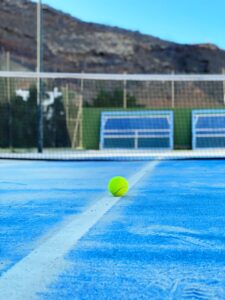Understanding the Different Types of Padel Serves and When to Use Them
3 min read
Understanding the Different Types of Padel Serves and When to Use Them
Padel, a fast-paced and exciting racquet sport, is gaining popularity all over the world. With its origins in Spain, padel combines elements of tennis and squash, making it a must-try for all sports enthusiasts.
One of the most crucial aspects of padel is the serve. A good serve can set the tone for the entire game and give you a strong advantage over your opponents. In this article, we will explore the different types of padel serves and when to use them.
1. Flat Serve
The flat serve is the go-to serve for most padel players. It involves hitting the ball directly towards the opponents’ side of the court, with little to no spin. This serve is ideal for gaining control of the game right from the start.
When to use it: The flat serve is perfect when you want to put your opponents under pressure right away. Use it when you have a strong partner who can cover the net well, allowing you to take control of the baseline.
2. Slice Serve
The slice serve is a variation of the flat serve, where you brush the ball with an upward motion to create spin. This type of serve causes the ball to bounce low and towards the corners, making it difficult for your opponents to return.
When to use it: Use the slice serve when you want to keep your opponents guessing and off balance. It’s especially effective when playing against opponents who struggle to handle low bouncing balls, forcing them to make errors or give you a weak return.
3. Kick Serve
The kick serve is a powerful and deceptive serve that involves hitting the ball with topspin. The topspin causes the ball to bounce high and away from your opponents, making it challenging for them to control the return.
When to use it: The kick serve is perfect when you want to disrupt your opponents’ rhythm and force them to hit defensive shots. It works well against opponents who like to stand close to the baseline, as the high bounce gives you time to move forward and take control of the net.
4. Lob Serve
The lob serve is a strategic and defensive serve that involves hitting the ball high in the air towards the back of the court. This serve is useful when your opponents are dominating the net and you need to buy time to reposition yourself.
When to use it: Use the lob serve when you’re in a defensive position and want to get back into the rally. It’s also effective against opponents who struggle to hit overhead shots, giving you a chance to regain control of the game.
How to Play the Baseline in Padel Doubles
Playing the baseline in padel doubles requires a blend of defensive and offensive skills. Here are some tips to help you master this crucial aspect of the game:
1. Stay Balanced
Always maintain a balanced stance and be ready to move in any direction. This will allow you to react quickly to your opponents’ shots and hit powerful returns.
2. Communication is Key
Constantly communicate with your partner to ensure you’re on the same page. Knowing each other’s strengths and weaknesses will help you cover the court effectively and determine the best strategy for the game.
3. Mix Up Your Shots
Don’t be predictable with your shots. Mix up your serves, returns, and groundstrokes to keep your opponents guessing and off balance. This will give you an edge and make it harder for them to anticipate your moves.
4. Be Aggressive at the Right Time
While playing the baseline, look for opportunities to be aggressive and take control of the net. When your opponents hit a weak shot or leave an opening, move forward quickly and put pressure on them by hitting powerful volleys or smashes.
In conclusion, understanding the different types of padel serves and knowing when to use them is essential to elevate your game. Mastering the baseline in padel doubles requires a combination of defensive skills, communication, and a strategic mindset. By implementing these tips, you’ll be well on your way to becoming a formidable padel player.







